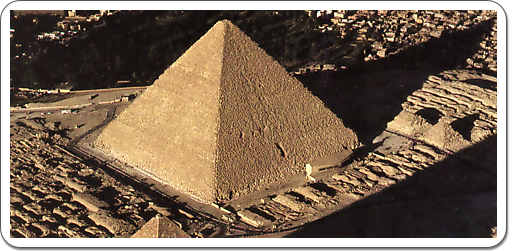
Air view on the Great Pyramid and the Queens' Pyramids next to it.
Source: Lehner, Complete Pyramids, p. 109.
Location
After his predecessor and father Snofru had chosen Dashur, on the southernmost edge of the Memphite necropolis, to build not one but two pyramids, Kheops moved north, to Giza, for his own funerary monument. His was the first of three royal pyramid complexes erected at this site: his son and second successor Khefren, and his grandson, Mykerinos, would both follow in his footsteps.
The move north, away from Dashur and towards the northern edge of the Memphite necropolis, may seem surprising at first. A lot of the material that was used to build the pyramids at Giza, however, was quarried on site, making it an ideal location for a project as ambitious as Kheops' funerary monument. The resources at Dashur may perhaps have been deemed exhausted for this project.In addition, a pyramid complex was much more than just a funerary monument for a king, or a testimony for his megalomania, as has often been assumed. It was also an important economic centre, housing priests and servants, controlling the flow of goods from the many royal estates to the temples.
Or Kheops might have preferred to built his monument at a site that had not yet been used before, just like his father did when he abandoned Meidum for Dashur.
Structure

Click or tap on the little circles on this map to learn more about the Great Pyramid.
Source: Lehner, Complete Pyramids, p. 109.
The pyramid complex of Kheops marks a further evolution in the building of pyramids and related temples. All the elements that would become traditional for future generations, were already present:
- The pyramid itself
- A small satellite pyramid, uncharacteristically located at the southeast corner of the pyramid, rather than along the southern face
- Subsidiary pyramids believed to have been built for several of Kheops' queens, including, perhaps, his mother, Hetepheres I
- A small Mortuary Temple in the east
- A Valley Temple, now mostly lost
- A causeway, now mostly lost, connecting the Valley Temple with the Mortuary Temple.
- Several pits (once) containing boats that the deceased king would need for his daily transportation in the afterworld, or that were used for the royal burial
Click on the thumbnails below to learn more about Kheops' funerary complex.